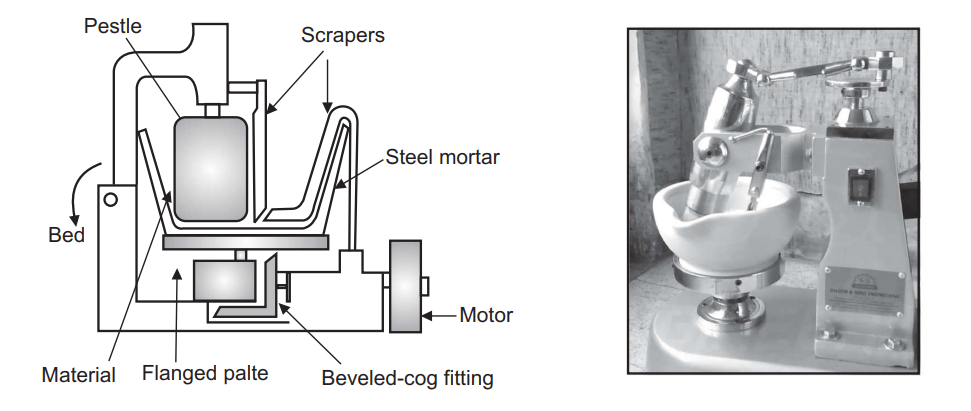An automated version of mortar and pestle size reduction equipment, the end-runner mill is comparable to the edge runner mill. The friction of material between the mortar and the pestle causes a heavy-weight pestle to revolve when the mortar is rotated by a motor at the base.
Table of Contents
Principle of end runner mill
The principle of size reduction applied in these mills is crushing due to the heavyweight of the stones or metal pestle and shearing force as a result of the movement of these stones or metal. In the end-runner mill, a weighted pestle is turned by the friction of material passing beneath it as the mortar rotates under powder to be processed.
Construction of end runner mill
End-runner mills are mechanical versions of the mortar and pestle method of comminution. This grinding apparatus consists of a stone or metal pestle connected by a shaft (Fig. 2.7). In a shallow steel or porcelain mortar, the pastel revolves on its axis. The pestle is generally in the shape of a dumbbell. At the bottom, the mortar is secured by a flanged plate. Scrappers are located in the center and on either side of the circular pan. The pestle is horizontally positioned and rotates against a powder bed.

Working of end runner mill
The material to be milled is fed into the centre of the circular mechanical mortar (pan) and is worked outwards by the action of the wheels and mill is operated. The pestle rotates against a bed of powders. Mortar revolves at high speed and causes the pestle to revolve. Scrapers are employed in scraping the material constantly from the bottom of the wheel and are feed back to the wheel were it gets crushed further. Finally, pestle is raised from the mortar manually or automatically to facilitate emptying and cleaning.
Uses:
- It is used to reduce fibrous crude drugs to a fine size.
- It used for grinding semisolid preparations such as ointments and pastes to fine size.
- It is used for uniform distribution of the contents in viscous dispersion medium.
- It can be used for both wet and dry grinding of crude drugs.
Merits:
- It has simple design and thus cleaning and maintenance is easy.
- It utilizes less electrical power.
- It produces fine and sometimes very fine particles.
- Requires less attention during the milling operation.
- It has no problem of chocking or clogging as it has no sieves for size separation.
Demerits:
- It runs only on batch operation.
- It is not suitable for milling sticky materials.
- Unsuitable for drugs which are hard and unbroken or in slightly broken condition.
- Machine noise causes lot of noise pollution.
- It requires scrapper adjustment intermittently.
Pharmaceutical engineering Question bank for B pharm sem-3